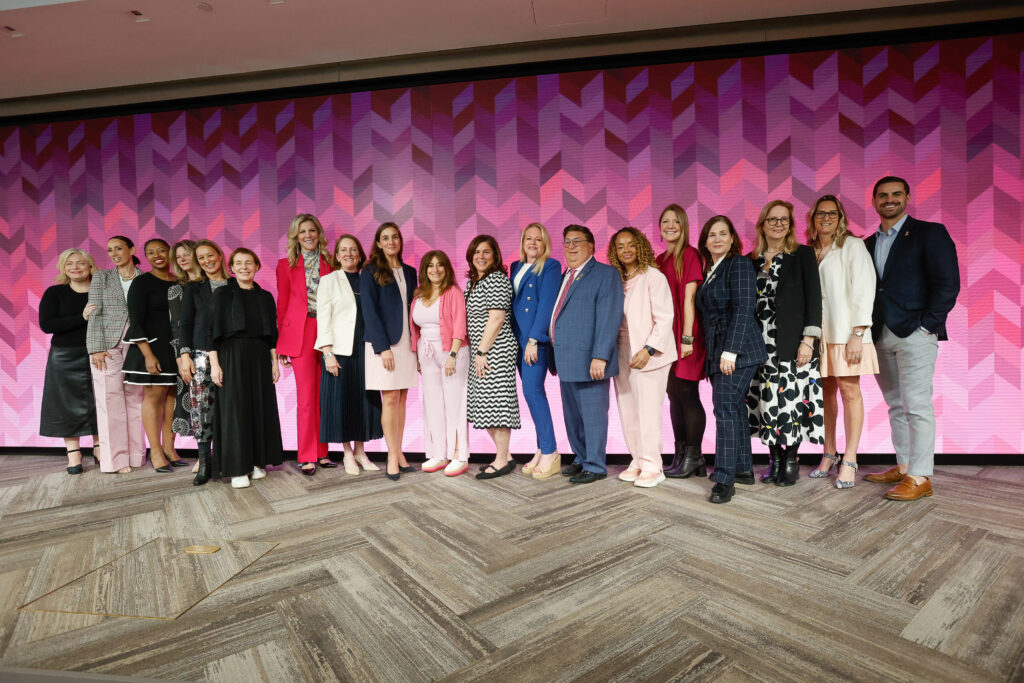Advertising Week returned to New York City this year for its first hybrid conference. With people joining both in-person and virtually, the event provided the perfect setting to discuss the need to pivot our thinking to meet modern realities. Much of the conversation focused on how to connect with consumers in this new world, where so much has changed.
If you were at Advertising Week in previous years, you probably heard people discussing the importance of talking “to” as opposed to “at” the audience. In 2021, it was all about talking “with” them. During the pandemic, consumers had had time to reflect on what’s truly important to them. Now, digital tools have empowered them to ask for—if not demand—what they want. The most successful brands will not only find ways to listen but also show customers that their voices are heard.
Here’s a recap of some of the most insightful sessions we attended:
CONTENT AND CONNECTING WITH AUDIENCES
OPPORTUNITIES AND RISKS OF NEW TECHNOLOGY
SHOWING UP FOR THE NEXT GENERATION
CONTENT AND CONNECTING WITH AUDIENCES
The Critical Role of Creators in Advertising
Dara Treseder, SVP, Head of Global Marketing & Communications, Peloton
Alvin Bowles, VP, Business Ecosystem Partnerships, Facebook
We’ve heard a lot of talk about the rise of the creator economy. This panel shared advice on unleashing its power for your brand:
Choose to work with creators who are real people and already embody the values of your brand. Don’t just go with people who have the most followers or are currently on trend. For example, Peloton using real instructors as brand ambassadors.
Brands are good at collecting data, but they’re not always great at analyzing it to find the truth that customers are seeking. Having a deep understanding of the data will allow you to align with content that resonates with your audience.
2020 gave us 20/20 vision. We need to understand the cultural context of the content we’re creating. Introspection and reflection are key. Ask yourself what role your brand is playing in the bigger picture. What are your values? Are you willing to really put these values into action in the real world?
Celebrate what’s real. Don’t fake it. Look for the pockets of authenticity between what your brand represents and what your customers need. Amplify ways your customers are already supporting your brand. For example, Peloton is helping build groups started by members.
The Power of Sound: Tapping Into the Audio Boom
Paul Kelly, CRO, A Million Ads
Fiona Benmayor, Associate Manager of Media Innovation & Partnerships, PepsiCo
Jenn LaRocco, VP, Strategic Accounts, SXM Media
Kelly Chiricotti, VP, Director, Spark Foundry
Michael Loper, VP Experience Strategy, RAPP
Suzanne Steers, Business Affairs and Marketing, Music, Audio Up
Audio has gone from a little icon on media slides to center stage in the customer journey. It’s the number one thing we’re doing on our phones, more than scrolling social feeds or gaming. Here are some insights on using audio effectively:
Audio was traditionally for upper-funnel objectives, but there has recently been much more lower-funnel performance based in the podcast space. A Spotify study found that more people are using audio because they want an escape from the overwhelm of visual media stimulation.
Personalization drives sales. Message is key in targeting. You can reach the right person, but if you’re not showing up in the right way, you’re not going to have an effect. The rise of digital audio is delivering data-driven opportunities for more personalization. Creative that responds to weather and customer location are good places to start, but we should continually look for more ways to customize the message.
The audio landscape is fragmented. Brands need to find ways to identify themselves, like distinctive audio cues and 3D experiences. What is the audio version of your logo? What is your sonic identity? Keep your content compelling, yet simple. Two people talking is, usually, more effective than asking audiences to follow a group conversation.
Up, Up and Away! How to Position Travel Brands for Growth in Today’s World
Sariah Dorbin, Executive Creative Director, Quigley
Laurinda Rainey, Managing Director, United Airlines Cobrand Cards, JP Morgan Chase
Luc Bondar, Vice President, Marketing & Loyalty and President, MileagePlus® United Airlines
Katie Kempner, Founder, Kempner Communications, Creator and Host, “Perspectives with Katie Kempner”
Travel is coming back but not necessarily in the way that we all thought it would. This panel of industry leaders discussed how to best position travel brands for growth in today’s world:
Focus on the “Why.” Before 2020, the travel planning process was typically short and transactional. Customers were mostly drawn to specific destinations and would look for the best value in getting there. Now, with so much uncertainty surrounding the return to travel, the “where” has become less important than the “why.” People are returning to travel with a new sense of thoughtfulness. Reconnecting with people we care about, and truly connecting with other cultures, has become more important than simply checking places off the bucket list. Creative content should reflect this new attitude toward travel.
Think beyond the rational. The most important word to keep in mind when thinking about content is “inspiration.” While rational benefits, like earning miles and getting travel perks, are still important, it’s also critical to give people a meaningful reason to travel by reflecting the larger emotional benefits. For example, Quigley recently partnered with The Points Guy to create travel comeback stories for the United Rewards Cards—a video series that illustrated the power of travel to bring people together and strengthen relationships.
Maintaining loyalty requires change. The pandemic forced many brands to become more nimble so that they could remain relevant to their customers. The travel industry was no exception. When travel and dining out stopped and consumer habits changed, the United Rewards Cards added more miles accelerators for purchases like food delivery services, groceries and online shopping. The brand also gave customers new ways to use their miles beyond booking flights, like redeeming for chef-led virtual cooking lessons. Travel brands must continue to find ways to meet their customers where they are as their needs continue to evolve.
Stand up for customer values. Today’s consumers need to feel good about the brands they’re choosing. Showing a shared commitment to customer values can be as important as promoting products or prices. Instead of shying away from a controversial subject, United took a definitive stand with their vaccination policy. Along with generating positive PR, this move resonated strongly with their customer base and brought new people to the brand who were aligned with their values.
Building Bridges: Creating Lasting Connections With Consumers
Mel Furze, Sr. Global Director, Customer Science, LinkedIn
Pam Russo, EVP and General Manager of Digital, Audacy
Mike DiGiacomo, SVP of The Content Room, AMC Networks
Cathy Muldowney, SVP of Programmatic Sales, Clear Channel Outdoor
Jeremy Goldman, Director, eMarketer Briefing, Insider Intelligence
Brands are not just about products. They’re about people, connections, and culture. Here are some tips on talking to modern audiences in effective ways:
Avoid the originality delusion. Being weird will get you attention, but brands are built through relevance and consistency. It’s better to repeat the right messages than come up with new things every month.
Standing out from the clutter means taking a risk. Find an original story. Create social currency. For example, Netflix took a risk on Squid Games, but they inspired communities and created connections with a story people relate to right now.
Think beyond video. Audio has become a valued companion for many people. People are listening longer on more devices.
Trust is the new brand equity. It’s a top factor in buying decisions. Forty-eight percent of buyers say sellers deliver false information. Brands can’t set out to create trust, but they can set out to earn it.
Keep it simple. Consumers around the world are overwhelmed with too many messages and too many options.
Be inclusive. Consumers want to see themselves reflected in content, but many people feel they’re not represented.
THE OPPORTUNITIES AND RISKS OF NEW TECHNOLOGY
The Future of Personalization: Is AI the Answer?
Jim DeLash, Marketing Director, Customer Experience (CX), Professional, GlaxoSmithKline
Mara Greenwald, Managing Director, Commerce & Biddable Media, Mindshare
Ali Gwin, Product Marketing Leader, IBM Watson Advertising
Mordecai, Principal, Mordecai Inc
Studies show that 80% of people are more likely to purchase when they get a personalized brand experience. Here are some ways AI can (and can’t) help as cookies and third-party identifiers go away:
Personalization is more than putting a name in the subject line of an email. It needs to be insights-driven and add real value for the customer. This is something that AI can help achieve by looking at all the data we collect and determine what is a true signal versus noise.
Don’t be creepy. Make sure people feel comfortable in the experiences they’re having. Just because you have data and can build a model about a person, it doesn’t mean that you should use it. Focus on harnessing AI to actually help consumers. For example, in the healthcare industry, AI is being used to remind people when they’ve missed their medication, let them know why they need to take it, and help them get their prescriptions filled.
Limit yourself to a couple KPIs. Combine metrics. Look at the numbers that really matter for your business goal. Engagement and time spent can be more important than a click-through. Be intentional with testing, as opposed to using a one-and-done philosophy.
Always make sure there is a learning you can move forward from. It’s OK to test and fail. What’s not scalable today might work in the future. Sometimes, test results are ahead of their time. For example, YouTube couldn’t have worked five years earlier.
Artificial Humanity
Harsh Kapadia, CCO, MRM East
Jeff Carvalho, Cofounder, Highsnobiety
Ian Mackenzie, Chief Creative Officer, Performance Art
Henry Ajder, Head of Policy and Partnerships, Metaphysic
MJ Zilla, Design Director & Strategist
The ability to create synthetic characters is here. Consider the recent Tom Cruise deep fake video that even fooled Justin Bieber. Here are some opportunities and risks to keep in mind as the technology moves forward:
The core of this technology revolves around using AI to create nonexistent people or virtual versions of real people. This presents a new ethical challenge. How do we maintain the humanity of the original person, especially if we’re talking about someone who is no longer with us? Who holds the copyright to their personality? Do we trust that the person’s wishes are being respected?
Does marketing need to slow down the use of this technology so that people aren’t confusing what’s real and what’s digital? We need to consider the mental health aspects of the technologies we’re using. For example, social face filters may seem like a clever way to promote a brand, but they can have a negative psychological impact on the audience.
The rapid rate of the improvement in the technology is increasing accessibility—beyond just large companies and studios. This opens the possibility for more people to express themselves. This is decentralizing content creation. Kids can build entire careers when they’re 12 by creating content.
When thinking about developing content for your brand, don’t get distracted by the technology. Use it as an enabler of the idea, not the idea itself.
Sponsoring the Metaverse
Chris Olimpo, CEO and Co-Founder, Arcadia
Master Tesfatsion, Senior Writer & On-Air Talent, Bleacher Report
There’s been a lot of talk about the metaverse. But what is it exactly, and how will it impact your brand?
Simply defined, the metaverse is a digital layer on top of the physical world that people will be able to enter via an AR/VR device (like glasses). Its development has been slowed by the lack of a hardware solution that’s comfortable, easily accessible and that provides a rich experience.
AR has traditionally been considered the leading technology for the metaverse because of the complexity and isolated nature of VR. But now, the newest VR headsets are making the technology easier to use and more social, including new multiuser experiences. The metaverse will likely be a hybrid of AR and VR.
People who understand the metaverse are forward-thinking. They’re audiences who are smart and don’t want to be sold random products. They want to be part of the future.
The metaverse is an inevitable future. Mark Zuckerberg has been putting large amounts of funding behind it (and considers the corporate name change to Meta). Apple has been hiring a lot of people to focus specifically on the metaverse. There are essentially two schools of thought: those who see the metaverse as a replacement for reality (like face filters) and those who see it as an enhancement of reality (VR games that inspire physical conditioning in the real world).
SHOWING UP FOR THE NEXT GENERATION
Don’t Call Them Gen Z—They Hate That
Jessica Spaulding, Head of Marketing, Cheetos
Kehinde Hassan, Director of Global Music Culture, Splice.com
Smita Reddy, U.S. Brand Chair, Edelman
Like every generation before them, Gen Z seeks to define their own culture and not to be put in a box. However, the digital world gives them more power to act on those beliefs. Some tips to keep in mind when working to connect with Gen Z:
Biggest misconception: Being digital-native means Gen Z doesn’t like connecting in real life. The opposite is true. The most effective digital campaigns are connected to real-life experiences. Brands must give Gen Z something to believe in and belong to.
Gen Z is very inclusive and collaborative. They are the sampling generation. They don’t see anything as being 100% original—from music, to fashion, to language, everything is sampled from somewhere. The most successful brands are not precious about their content and allow it to be used, reworked, and shared.
If you have a Gen Z person in your organization, bring them into the fold when you think about content. This is the best way to ensure you’re being authentic and relevant. Algorithms are not going to tell you what Gen Z is doing. You need to actually be on the platforms. Spend time with them and discover what influences them. Look beyond the data. How have their lives been disrupted, and how is this changing the fabric of our society?
Gen Z is less impressed by celebrity status. They don’t want record deals or to be on TV. They admire the platforms over the celebrities that are on them.
Gen Z doesn’t necessarily not like being marketed to, but they don’t want marketing to define them. They’re especially wary of posturing by brands. They want brands to be in service of culture and not simply steal from it.
Forty-eight percent of Gen Z are multicultural. They want to see that reflected in the content they consume.
Empowering Female Voices for the Next Generation of Leaders
Stephanie Chung, Chief Revenue Officer, Wheels Up
Stefana Rusu, SVP Marketing & Co-Founder Acxiom Women LEAD, Acxiom
JoAnna Foyle, SVP of Inventory Partnerships, The Trade Desk
Representation of women across management has increased. But the pandemic has been especially hard on women in the industry. They’ve been largely carrying the burden of emotional and mental leadership and support in companies. This has led one in three women to consider stepping out or stepping back. Here are some things our industry can do to help:
Diversity is easy, inclusion is hard. There still needs to be more representation by women leaders in conversations about the directions of companies.
Women are less likely to advocate for themselves. Companies need to build systems to shine light on good performance, no matter where it’s coming from. So that when promotions come up, everyone is seen.
For women, it’s important to make sure your achievements are recognized. Be mindful of personal brand. You likely won’t be in the room when many important decisions about your career are being discussed by stakeholders. Make sure your personal brand can stand on its own and support your achievements. Make sure you are results driven. Set yourself up so you’re trackable.






